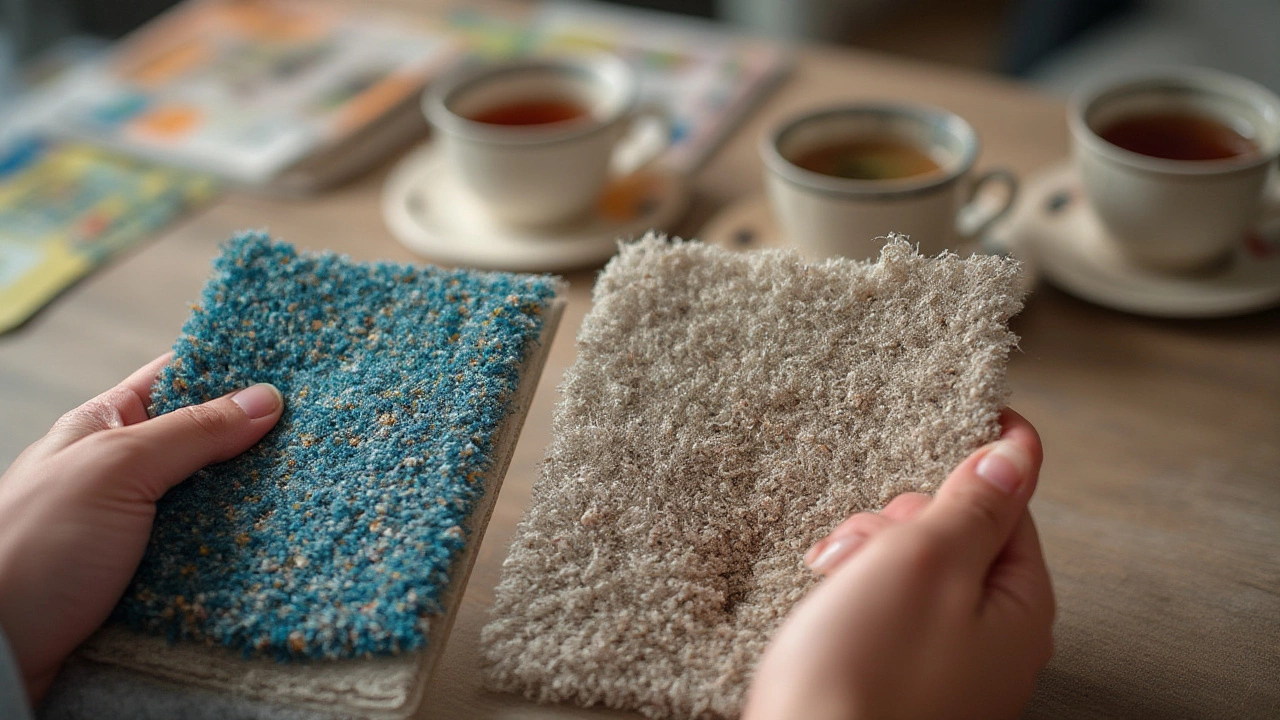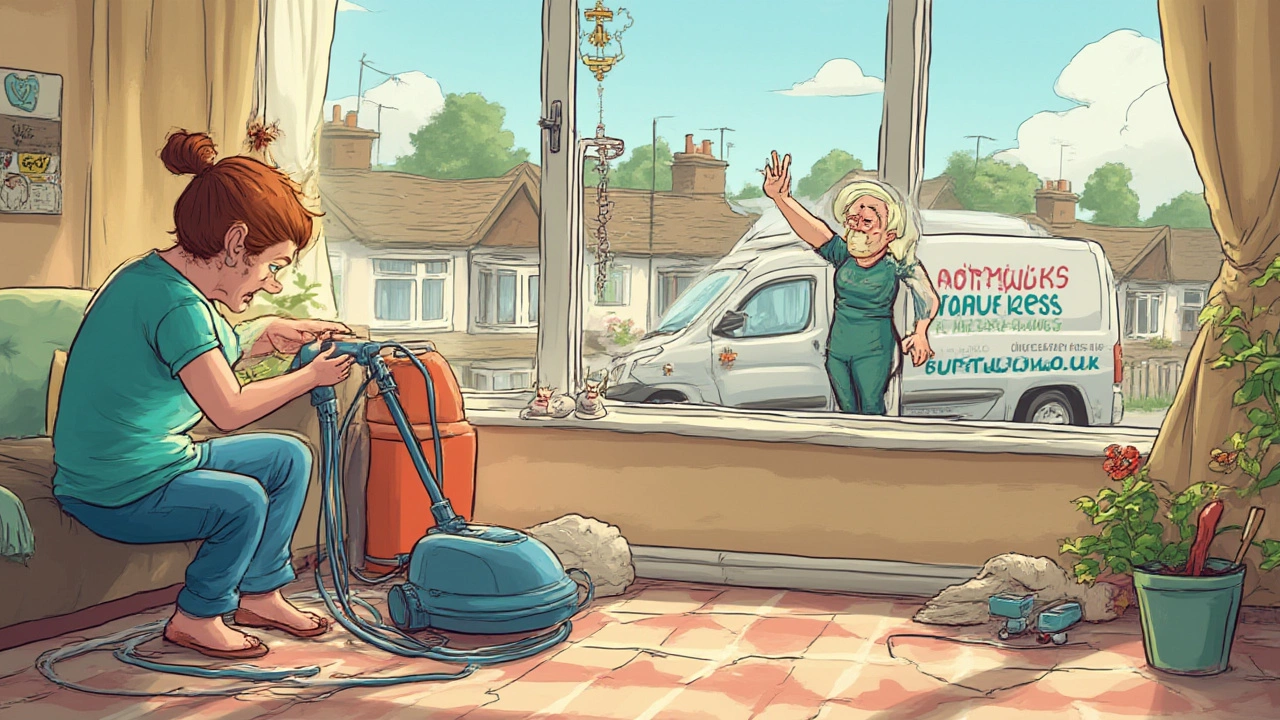Ever dropped a glass of red wine or watched muddy paws sprint across your living room rug? Few household sights trigger more panic—and more debate. Is it time to call in the professionals? Or will hiring a cleaner just drain your wallet for results you could easily match yourself? The battle between professional carpet cleaning and DIY is fierce, partly because carpets aren’t cheap and we all want to squeeze every last year out of them. But is the pro route really worth it?
The Real Difference Between Professional and DIY Carpet Cleaning
If you’ve walked into a carpet cleaning aisle at the store, you’ve seen shelves stocked with foams, sprays, powders, and portable shampoo machines. The promise: freshen up your floors in a day, no sweat. But here’s the thing—at-home products work differently than the high-powered machines pros use. Most DIY carpet cleaners use hot water extraction, but rented units typically run at half the suction power of pro equipment. That matters more than you think. Weak suction leaves behind water and detergent, so carpets not only take longer to dry but also build up residue that attracts grime faster.
Professional cleaners bring bulky, truck-mounted systems with industrial-strength suction. These machines inject hot water and a cleaning solution deep into the fibres, then suck nearly all the water right back out—along with dust mites, pollen, pet hair, and years of invisible foot traffic crud. According to a 2023 survey by the Carpet and Rug Institute, truck-mounted hot water extraction removes up to 94% of allergens buried in carpets. Rented machines typically pull closer to 60-70%. This is why pros can confidently offer results that last. Most industry guidelines recommend a professional clean every 12-18 months—not just for looks, but for health.
So when you spritz that DIY spray or run the small machine over your rug, you see instant surface change. It’s like wiping a foggy mirror—fast, but not the same as a deep scrub. Notice lingering odours? That’s bacteria the DIY route probably didn’t touch. If you’ve got allergies, pro cleaning is a game-changer; it actually improves indoor air quality, which can help with symptoms like sneezing or itching. A 2022 Australian study found allergy sufferers reported up to 60% fewer symptoms after a professional carpet clean versus home efforts.
Your Wallet and Your Weekend: Who Really Saves Money?
If you’re the budgeting type, the first thing you check is the price. DIY cleaning always seems friendlier on paper. Rented machines average $30-$40 a day, not counting detergents and extras. Hiring a pro in the UK runs anywhere from £25 per room to £50 or more for premium treatment. For a whole house, you’re looking at north of £200, depending on the number of rooms and whether you add extras like stain protection.
But the price tags aren’t everything. DIY jobs can break your back. Hauling heavy machines up and down stairs feels like a workout. And let’s not ignore drying time—because most rented units leave carpets soaked, it can take 8–24 hours for floors to dry. Ever tiptoe around your house in socks all Saturday? That’s the reality for lots of people who go the do-it-yourself route. Don’t even mention the heartbreak of a cleaning mistake—like over-wetting, which can cause mould beneath the carpet, or shampoo stains that never fully disappear.
Professionals show up, move furniture, treat stubborn spots, run their gear, and are out the door before you can finish your second coffee. Most carpets are dry in just a few hours, thanks to better suction. And if they mess up, their insurance covers it. Homeowners insurance? Not so forgiving. In the long run, DIY can be cheaper for frequent, light cleans. But if you’re after one big reset for spring (or after a big party), there’s good reason many families call the pros.

Deep Clean Myths: What the Ads Don’t Tell You
Do you need pro carpet cleaning every year? Is carpet shampooing actually bad for your floor? Will carpets shrink or colours fade when you blast them? Plenty of myths stick around, usually from old-school advice that hasn’t caught up to modern carpet science.
One biggie: Some think vacuuming and spot sprays are enough. Not even close. A 2024 study by ChemDry showed that weekly vacuuming only removes about half the dirt in dense carpets. Over years, ground-in grit acts like sandpaper, wearing away at carpet fibres until the pile flattens or, worse, holes appear. Pro cleaning doesn’t “wear down” carpet—it lifts out the dreaded stuff your vacuum can’t reach.
Another myth: all pro services use harsh chemicals. Actually, most now offer “green” cleaning with eco-friendly, biodegradable solutions. Some companies even use carbonation or encapsulation with barely any residue left behind. Ask before you book, especially if you have pets or kids rolling around.
About shrinkage or fading: Modern synthetic carpets rarely shrink if dried quickly, and most dye-locked fibres handle even the hottest steam without issue. The horror stories usually come from 70's or 80's-era wool carpets, which are a rarity now.
And that wildest myth of all: that home cleaning is just as good as what the pros do. Take a look at this quick table breaking down cleaning power:
| Method | Average Water Removal (%) | Allergen Reduction (%) | Dry Time (hours) |
|---|---|---|---|
| DIY Rented Machine | 40% | 60-70% | 8-24 |
| Professional Truck-Mounted | 80-90% | 90-95% | 2-4 |
Seeing is believing. The difference can make or break your living room’s freshness.
When To Call In The Pros: Signs Your Carpet Needs Expert Help
It’s tempting to keep putting off a professional job, but sometimes your carpet sends clear SOS signals. Got recurring dark patches, musty smells that no spray can kill, or weird ripples or stiffness? Those are red flags. DIY efforts can mask problems for a while, but deep-set stains from wine, pet accidents, or grease often resurface in weeks if not treated professionally. That’s because home machines can’t lift the stuff that’s soaked through the pad.
High-traffic hallways and stairs usually look dull and feel sticky after a few years, especially if you haven’t stuck to regular deep cleans. If your carpet “crunches” underfoot, leftover soap or water is to blame—hinting it’s time to get the pros in with their rinse cycles and powerful dryers. People with allergies are often surprised by the difference after a professional deep clean. Dust and pollen bury deep, triggering sneezing fits or watery eyes, but pro-level hot water extraction can yank out these invisible irritants in a way home kits can’t match.
Mold is another troublemaker. If you had a leak or flood and didn’t dry the carpet in under 48 hours, mould could be growing below the surface. These spores can aggravate breathing and cause health issues. Professional cleaners can spot, treat, and, in some cases, recommend replacement if the problem’s too far gone.

Tips for Smart Carpet Cleaning: Mixing DIY with Professional Power
Does professional carpet cleaning mean you forget about your vacuum? Not a chance. The best approach is a combo: stick to weekly vacuuming—move slowly, and go over areas twice for better pickup. Tackle fresh spills immediately by blotting (never scrubbing—unless you want a giant fuzzy patch as a “souvenir”). Sprinkle baking soda for mild odours, let it sit, and vacuum it up after 30-60 minutes.
When using a rental machine, avoid using extra detergent. More isn’t always better; leftover soap acts as a dirt magnet. Always rinse after you shampoo, and open the windows to speed up drying—never let carpets stay wet for more than eight hours.
Treat pro cleaning as your annual “carpet renewal day.” Schedule it after winter (when mud buildup is highest) or once kids and pets have tracked in enough mayhem. If you or someone in your house has severe allergies, doing a professional clean every 6-12 months helps. Several cleaning companies offer package deals for regular service—don’t be afraid to ask or negotiate, especially in quieter seasons.
Thinking about eco-friendliness? Choose a cleaner that uses biodegradable products or low-water-consumption machines. Want peace of mind? Ask for details on their cleaning process and customer satisfaction guarantees.
Mixing both strategies gives you the cleanest, safest carpets—without draining your bank or making you a prisoner of your weekend.
